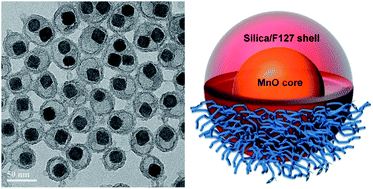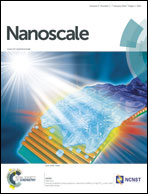Silica–F127 nanohybrid-encapsulated manganese oxide nanoparticles for optimized T1 magnetic resonance relaxivity†
Abstract
To properly engineer MnO nanoparticles (MONPs) of high r1 relaxivity, a nanohybrid coating consisting of silica and F127 (PEO106PPO70PEO106) is designed to encapsulate MONPs. Achieved by an interfacial templating scheme, the nanohybrid encapsulating layer is highly permeable and hydrophilic to allow for an optimal access of water molecules to the encapsulated manganese oxide core. Hence, the efficacy of MONPs as MRI contrast agents is significantly improved, as demonstrated by an enhancement of the MR signal measured with a pre-clinical 7.0 T MRI scanner. The nanohybrid encapsulation strategy also confers high colloidal stability to the hydrophobic MONPs by the surface decoration of PEO chains and a small overall diameter (<100 nm) of the PEO–SiO2 nanohybrid-encapsulated MONPs (PEOMSNs). The PEOMSNs are not susceptible to Mn-ion leaching, and their biocompatibility is affirmed by a low toxicity profile. Moreover, these hybrid nanocapsules exhibit a nano-rattle structure, which would favor the facile loading of various therapeutic reagents for theranostic applications.


 Please wait while we load your content...
Please wait while we load your content...